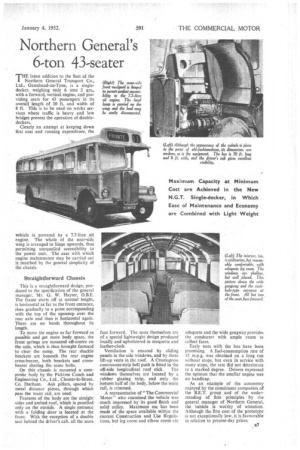Northern General's 6-ton 43-seater
Page 41

If you've noticed an error in this article please click here to report it so we can fix it.
THE latest addition to the fleet of the Northern General Transport Co., Ltd., Gateshead-on-Tyne, is a singledecker, weighing only 6 tons 2 qrs., with a forward, vertical engine, and providing seats for 43 passengers in its overall length of 30 ft. and width of 8 ft. This is to be used on works services where traffic is heavy and low bridges prevent the operation of doubledeckers.
Clearly an attempt at keeping down first cost and running expenditure, the vehicle is powered by a 7.7-litre oil engine. The whole of the near-side wing is arranged to hinge upwards, thus permitting unequalled accessibility to The power unit.. The ease with which engine maintenance may be carried out is matched by the general simplicity of the chassis.
Straightforward Chassis This is a straightforward design, produced to the specification of the general manager, Mr. G. W. Hayter, O.B.E. The frame starts off at normal height, is horizontal as far as the front entrance, rises gradually to a point corresponding with the top of the upsweep over the rear axle and then is horizontal again. There are no bends throughout its length.
To move the engine as far forward as possible and get more body space, the front springs are mounted off-centre en the axle, which is thus brought forward to clear the sump. The Tear shackle brackets are beneath the rear engine cross-bearer, both brackets and crossbearer sharing the same bolts.
On this chassis is mounted a composite body by the Picktree Coach and Engineering Co.' Ltd., Chester-le-Street, Co. Durham. Ash pillars, spaced by metal distance pieces, through which pass the waist rail, are used
Features of the body are the straight sides and arched roof, which is panelled only on the outside. A single entrance with a folding door is located at the front. With the exception of a double seat behind the driver's cab, all the seats face forward. The seats themselves are of a special lightweight design produced locally and upholstered in moquette and leather-cloth.
Ventilation is ensured by sliding panels in the side windows, and by three lift-up vents in the roof. A Cromapress continuous-strip bell push is fitted in the off-side longitudinal roof stick. The windows themselves are located by a rubber glazing strip, and only the bottom half of the body, below the waist rail, is trimmed.
A representative of" The Commercial Motor" who examined the vehicle was ,much impressed by its good finish and solid utility. Maximum use has beers made of the space available within the current ConstructiOn and Use Regulations, but leg room and elbow room are
adequate and the wide gangway provides the conductor with ample room to collect fares.
Early tests with the bus have been promising. A fuel-consumption rate of 15 m.p.g. was obtained on a long run without stops, but even in service with many stops, the rate did tint deteriorate to a marked degree. Drivers expressed the opinion that the smaller engine was no handicap.
As an example of the autonomy enjoyed by the constituent companies of the B.E.T. group and of the understanding of first principles by the general manager of Northern General, the vehicle is worthy of attention. Although the first cost of the prototype is not exceptionally low, it is favourable in relation to present-day prices.




















































































